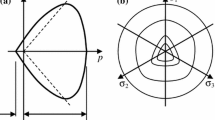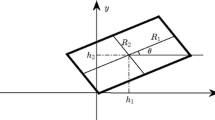Abstract
Deformation studies require that geological bodies are kinematically moved along faults. Fault-parallel flow is one of a small number of kinematic restoration algorithms developed for this purpose. This scale-independent method describes how material nodes are displaced parallel to the fault plane, in the direction of fault movement. The one-dimensional strain of linear objects and two-dimensional strain of bodies within the hanging-wall during the restoration is shown for all cutoff angles and all angles of fault bends. A line moving over a fault bend is either shortened or extended depending on its initial orientation. However, the elongation of the line is significantly different under shortening and extension, with respect to the fault bend angle. The geometries of compressional fault systems, in which faults change angle by about 20 to 40°, generate low values of elongation. Modeling of extensional faults, which typically have steeper dips (60 to 80°) and therefore have tighter fault bends, causes high, unnatural values of elongation. The calculated strain ellipse ratios are directly proportional to the fault bend angle, corroborating the one-dimensional results. The fault-parallel flow method should be used primarily to kinematically restore and forward-model compressional faults, and other faults where the fault bend angles do not exceed 40°.









Similar content being viewed by others
References
Allmendinger RW (1998) Inverse and forward numerical modeling of trishear fault-propagation folds. Tectonics 17(4):640–656
Anderson EM (1951) The dynamics of faulting and dyke formation with applications to Britain. Oliver & Boyd, Edinburgh
Apotria TG (1995) Thrust sheet rotation and out-of-plane strains associated with oblique ramps: an example from the Wyoming salient USA. J Struct Geol 17(5):647–662
Buddin TS, Kane SJ, Williams GD, Egan SS (1997) A sensitivity analysis of 3-dimensional restoration techniques using vertical and inclined shear constructions. Tectonophysics 269(1–2):33–50
Burkhard M (1990) Ductile deformation mechanisms in micritic limestones naturally deformed at low temperatures (150–350 °C). Geol Soc Lond Spec Publ 54(1):241–257
Cartwright JA, Trudgill BD, Mansfield CS (1995) Fault growth by segment linkage: an explanation for scatter in maximum displacement and trace length data from the Canyonlands Grabens of SE Utah. J Struct Geol 17(9):1319–1326
Dahlstrom CDA (1969) Balanced cross sections. Can J Earth Sci 6:743–754
Doglioni C (1985) The overthrusts in the Dolomites: ramp-flat systems. Eclogae Geol Helv 78(2):335–350
Durand-Riard P, Caumon G, Muron P (2010) Balanced restoration of geological volumes with relaxed meshing constraints. Comput Geosci 36(4):441–452
Egan SS, Buddin TS, Kane SJ, Williams GD (1997) Three-dimensional modelling and visualisation in structural geology: New techniques for the restoration and balancing of volumes. Proceedings of the 1996 geoscience information group conference on geological visualisation. Electron Geology, 1:67–82
Elliott D (1983) The construction of balanced cross sections. J Struct Geol 5:101
Erslev EA (1991) Trishear fault-propagation folding. Geology 19(6):617–620
Fischer MW, Coward MP (1982) Strains and folds within thrust sheets: an analysis of the Heilam sheet, northwest Scotland. Tectonophysics 88(3–4):291–312
Gibbs A (1983) Balanced cross-section construction from seismic sections in areas of extensional tectonics. J Struct Geol 5(2):153–160
Guzofski CA, Mueller JP, Shaw JH, Muron P, Medwedeff DA, Bilotti F, Rivero C (2009) Insights into the mechanisms of fault-related folding provided by volumetric structural restorations using spatially varying mechanical constraints. Am Assoc Pet Geol Bull 93(4):479–502
Hossack J (1979) The use of cross sections in the calculations of orogenic contraction. J Geol Soc Lond Phys 136:705–711
Kane SJ, Williams GD, Buddin TS, Egan SS, Hodgetts D (1997) Flexural-slip based restoration in 3D, a new approach. Am Assoc Petr Geol Annual Convention Official Program A 58
Klein E, Baud P, Reuschlé T, Wong T-f (2001) Mechanical behaviour and failure mode of Bentheim sandstone under triaxial compression. Phys Chem Earth (A) 26(1–2):21–25
Laubscher HP (1988) Décollement in the Alpine system: an overview. Geol Rundsch 77(1):1–9
Li C, Prikryl R, Nordlund E (1998) The stress-strain behaviour of rock material related to fracture under compression. Eng Geol 49(3–4):293–302
Lohr T, Krawczyk CM, Oncken O, Tanner DC (2008) Evolution of a fault surface from 3D attribute analysis and displacement measurements. J Struct Geol 30(6):690–700
Maerten L, Maerten F (2006) Chronologic modeling of faulted and fractured reservoirs using geomechanically based restoration: technique and industry applications. Am Assoc Pet Geol Bull 90(8):1201–1226
Midland Valley Exploration Ltd (2012) Move2012.2 software. Glasgow
Moretti I, Lepage F, Guiton M (2006) KINE3D: a new 3d restoration method based on a mixed approach linking geometry and geomechanics. Oil Gas Sci Technol—Rev IFP 61(2):277–289
Passchier CW (1990) Reconstruction of deformation and flow parameters from deformed vein sets. Tectonophysics 149:323–338
Peacock DCP, Parfitt EA (2002) Active relay ramps and normal fault propagation on Kilauea Volcano, Hawaii. J Struct Geol 24(4):729–742
Plesch A, Shaw JH, Kronman D (2007) Mechanics of low-relief detachment folding in the Bajiaochang field, Sichuan Basin China. Am Assoc Pet Geol Bull 91(11):1559–1575
Ramsay JG, Huber MI (1983) The techniques of modern structural geology. Strain analysis, vol 1. Academic Press, London
Schultz-Ela DD (1991) Restoration of cross-sections to constrain deformation processes of extensional terranes. Mar Petroleum Geol 9(4):372–388
Spang JH, Wolcott TL, Serra S (1981) Strain in the ramp regions of two minor thrusts, southern Canadian Rocky Mountains. In: Mechanical behavior of crustal rocks. Geophys Monogr Ser, vol 24, pp 243–250. Am Geogphys Union, Washington
Suppe J (1983) Geometry and kinematics of fault-bend folding. Am J Sci 283(7):684–721
Tanner DC, Krawczyk CM, Oncken O, Tight Gas Working Group (2002) Towards three-dimensional retro-deformation of the Rotliegend strata of the ‘Tight Gas’ area, North German Basin. Boll Geofis Teor Appl 42:318–321
Tanner DC, Behrmann JH, Dresmann H (2003) Three-dimensional retro-deformation of the Lechtal Nappe, Northern Calcareous Alps. J Struct Geol 25(5):737–748
Tanner DC, Bense FA, Ertl G (2011) Kinematic retro-modelling of a cross-section through a thrust-and-fold belt: the Western Irish Namurian Basin. Geol Soc Spec Publ 349(1):61–76
Walsh JJ, Watterson J (1988) Analysis of the relationship between displacements and dimensions of faults. J Struct Geol 10(3):239–247
Walsh JJ, Watterson J, Bailey WR, Childs C (1999) Fault relays, bends and branch-lines. J Struct Geol 21(8–9):1019–1026
Walsh JJ, Nicol A, Childs C (2002) An alternative model for the growth of faults. J Struct Geol 24(11):1669–1675
Withjack MO, Peterson ET (1993) Prediction of normal-fault geometries; a sensitivity analysis. Am Assoc Pet Geol Bull 77:1860–1873
Woodward NB, Boyer SE, Suppe J (1989) Balanced geological cross sections: an essential technique in geological research and exploration, 2nd edn. Studies in Geology, vol 11. University of Tennessee, Knoxville
Zhao CY, Song HB, Qian RY, Song Y, Huang XH, Chen L, Tian LH (2010) Research on tectono-thermal evolution modeling method for superimposed basin with the Jianghan Basin as an example. Acta Geophys Sin 53(1):128–137
Zoback MD (2007) Reservoir geomechanics. Cambridge University Press, Cambridge
Acknowledgments
We thank Midland Valley Exploration Ltd for their software suite Move2012 and for numerous discussions. The authors thank the reviewers Jean-Pierre Gratier and Andreas Plesch for their constructive and helpful comments. Steffi Burchardt is thanked for Fig. 1a. This work is part of the project PROTECT that is funded through the Geotechnologien research programme in Germany (grant 03G0797, publication number GEOTECH-2056).
Author information
Authors and Affiliations
Corresponding author
Appendices
Appendix A: Calculation of Elongation and Change in Angles During Fault-Parallel Flow
The following equations were modified after Tanner et al. (2003), and are related to Fig. 10. They show shortening and extension of material lines for concave (case 1) and convex (case 2) fault bends. The material lines move along flow paths (dashed line) that are parallel to the fault surface, in the direction of movement. The two fault segments are defined by a flow deflector (fd) that bisects the angle of the fault bend apex. If two fault segments are defined by the angles θ 1 and θ 2, then η is equal to the bisecting angle. The equations are related to triangles in Fig. 10. Every point in Fig. 10 is defined by its x and y coordinates.
The calculation of the half fault bend angle η for all variations is defined as

where the angles θ 1 and θ 2 define the dip of the fault segments.
Appendix B: Concave Fault Bends, Case 1: 0°<η<90° for α 1 (Fig. 10(a))
The original length of the line A–B (l 0) is given by the sine rule on the triangle ABD,

The length h is the distance between the fault surface and the flow path line. Using the sine rule, h is given by

After deformation the length of line C–D (l 1) is given by the triangle ACD,

and the new cutoff angle ϕ is, using the arc sine rule, given as

The elongation e of a line is defined as

Using the sine rule, the shear strain g is

in which the angular shear γ describes the change in angle between the original line (l 0) and the deformed line (l 1). γ is defined as

The strain ratio R f is equal to the ellipticity of a body that was originally a circle and is given as

After displacement z along the flow path lines, the coordinates of the points C and D that define a line can be determined by the following equations

and

To restore initial line length and cutoff angle, the displaced hanging-wall line can be transformed by simple shear, parallel to the path flow lines of the second dip domain, to the new line C–E. The coordinates of E are defined as

Appendix C: Concave Fault Bends, Case 1: 0°<η<90° for α 2 (Fig. 10(b))
For e and g see Eqs. (6) and (7). Other equations change accordingly. Thus

The equation for h is equivalent to Eq. (3), except angle α 1 replaces α 2. Thus




x C , y C and x D , y D are as in Eqs. (10) and (11). Thus

Appendix D: Convex Fault Bends, Case 2: 90°<η<180° for α 2 (Fig. 10(c))
For e, g, l 0, h, l 1 and ϕ, see Eqs. (6) and (7), and (13) to (16),




Appendix E: Convex Fault Bends, Case 2: 90°<η<180° for α 1 (Fig. 10(d))


Appendix F: Calculation of Two-Dimensional Area Change
The calculation of the original thickness of the hanging-wall block is defined as follows (see Fig. 7)

and

where t 0 and t 1 are the thicknesses before and after deformation. The areas A 0 and A 1 are given by

The length b and h b are the sides of the parallelogram formed by the bed between flow lines (e.g. Fig. 7).
Rights and permissions
About this article
Cite this article
Ziesch, J., Tanner, D.C. & Krawczyk, C.M. Strain Associated with the Fault-Parallel Flow Algorithm During Kinematic Fault Displacement. Math Geosci 46, 59–73 (2014). https://doi.org/10.1007/s11004-013-9464-3
Received:
Accepted:
Published:
Issue Date:
DOI: https://doi.org/10.1007/s11004-013-9464-3





